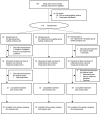Lubiprostone in chronic kidney disease: Insights into mitochondrial function and polyamines from a randomized phase 2 clinical trial
- PMID: 40880481
- PMCID: PMC12396341
- DOI: 10.1126/sciadv.adw3934
Lubiprostone in chronic kidney disease: Insights into mitochondrial function and polyamines from a randomized phase 2 clinical trial
Abstract
Chronic kidney disease (CKD) is a life-threatening condition, and constipation is a progressive risk factor. We evaluated changes in uremic toxins, renal function, and the safety of lubiprostone, a selective chloride channel activator, in patients with CKD. In this phase 2, randomized, double-blind, placebo-controlled trial across nine centers in Japan, 150 patients with stage IIIb-IV CKD received lubiprostone (8 or 16 micrograms) or placebo for 24 weeks. The primary end point was change in indoxyl sulfate levels. Secondary end points included other uremic toxins and renal function markers. Lubiprostone did not alter uremic toxin levels but improved or preserved estimated glomerular filtration rate and its slope in the 16-microgram group. Mild-to-moderate gastrointestinal events occurred in the placebo and 16-microgram groups. Multiomics analysis revealed that lubiprostone modulated the gut microbial agmatine pathway and increased spermidine levels, thereby improving renal mitochondrial function. Lubiprostone is a previously unknown and safe therapeutic option to mitigate renal decline in CKD.
Figures






References
-
- Levin A., Tonelli M., Bonventre J., Coresh J., Donner J. A., Fogo A. B., Fox C. S., Gansevoort R. T., Heerspink H. J. L., Jardine M., Kasiske B., Kottgen A., Kretzler M., Levey A. S., Luyckx V. A., Mehta R., Moe O., Obrador G., Pannu N., Parikh C. R., Perkovic V., Pollock C., Stenvinkel P., Tuttle K. R., Wheeler D. C., Eckardt K. U., ISN Global Kidney Health Summit participants , Global kidney health 2017 and beyond: A roadmap for closing gaps in care, research, and policy. Lancet 390, 1888–1917 (2017). - PubMed
-
- Vanholder R., Annemans L., Braks M., Brown E. A., Pais P., Purnell T. S., Sawhney S., Scholes-Robertson N., Stengel B., Tannor E. K., Tesar V., van der Tol A., Luyckx V. A., Inequities in kidney health and kidney care. Nat. Rev. Nephrol. 19, 694–708 (2023). - PubMed
-
- Taguma Y., Kitamoto Y., Futaki G., Ueda H., Monma H., Ishizaki M., Takahashi H., Sekino H., Sasaki Y., Effect of captopril on heavy proteinuria in azotemic diabetics. N. Engl. J. Med. 313, 1617–1620 (1985). - PubMed
-
- Lewis E. J., Hunsicker L. G., Bain R. P., Rohde R. D., The effect of angiotensin-converting-enzyme inhibition on diabetic nephropathy. The Collaborative Study Group. N. Engl. J. Med. 329, 1456–1462 (1993). - PubMed
-
- Brenner B. M., Cooper M. E., de Zeeuw D., Keane W. F., Mitch W. E., Parving H. H., Remuzzi G., Snapinn S. M., Zhang Z., Shahinfar S., Investigators R. S., Effects of losartan on renal and cardiovascular outcomes in patients with type 2 diabetes and nephropathy. N. Engl. J. Med. 345, 861–869 (2001). - PubMed
Publication types
MeSH terms
Substances
LinkOut - more resources
Full Text Sources

